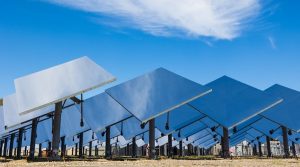They heated ceramic particles to a blistering 1450 F by dropping them through a beam of concentrated sunlight.
A breakthrough at a concentrated solar power facility in Australia could help transform solar energy in the future.
The challenge: Solar energy is cheap, clean, and plentiful, but its variability is holding it back: we can always burn coal or gas when we need it, but the sun is on its own schedule.
Storing excess solar energy can help smooth over this issue. Some solar plants stash extra solar-generated electricity in huge banks of lithium-ion batteries for use later, but there are drawbacks: they’re expensive, constantly self-discharging, and sometimes catch fire.
Lithium batteries are a key piece of the puzzle, especially for short-duration power fluctuations, but we’ll likely need an array of solutions for longer-term energy storage.
Concentrated solar power: Another option is to store solar energy as heat, rather than electricity, and if you ever spent a hot summer day playing with a magnifying glass as a kid, you know firsthand that you can dramatically increase the temperature of sunlight by concentrating it into a narrow beam.
Energy experts know that, too, which is why concentrated solar power systems exist.
These systems use banks of huge mirrors to focus sunlight on a single target. That concentrated solar power is then used to heat up a material, usually molten salt, which can act like a battery, temporarily holding the energy until we want to use the heat to create steam to spin a turbine.
What’s new? CSIRO, Australia’s national science agency, is testing a different storage approach at a concentrated solar power research facility in Newcastle, allowing tiny ceramic particles to fall through a beam of concentrated solar energy.
The agency has now reported that it was able to get the particles to reach a milestone temperature of 803 degrees Celsius (1477 degrees Fahrenheit) with this approach. It could then bank the thermal energy for up to 15 hours by stashing the ceramic particles in a silo.
For comparison, molten salt can typically only reach about 600 C (1112 F) and hold heat for 10 or so hours.
“[T]he heat-storing ceramic particles in this system were originally developed for use in unconventional natural gas ‘fracking,’” said John Pye, an associate professor at the Australian National University who helped develop the technology. “They are cheap and strong as well as stable enough to withstand many cycles of intense heating and cooling.”
If the team had simply aimed the solar energy at a container containing these particles, some of the heat would be lost as it traveled through the container material — this happens with the steel holding molten salt in traditional concentrated solar power systems.
Having the particles fall through the beam eliminates this container resistance, and by making precise adjustments to the speed at which the particles fell, the CSIRO team was able to increase the amount of heat they could store. With further optimization of the system, they believe they’ll be able to go even hotter — ceramics are able to endure temperatures over 1000 C (1832 F).
“This technology is key to delivering low-cost renewable energy at scale for the decarbonisation of Australia’s heavy industry,” said Jin-Soo Kim, leader of CSIRO’s solar technologies team. “Over eight years of development and thousands of hours were invested to reach this outcome.”
Global effort: CSIRO isn’t the only group exploring this approach to solar storage.
The US Department of Energy has been testing heating up falling ceramic particles since 2015, and in February, it broke ground on a “multi-megawatt” new falling particle facility in New Mexico. Construction on it is expected to wrap in 2024.
“Next-generation [concentrated solar power] has the potential to be a game-changer,” said Alejandro Moreno, the DOE’s Acting Assistant Secretary for Energy Efficiency and Renewable Energy. “This pilot facility will demonstrate how CSP systems can meet the challenges of providing long-duration energy storage while reducing costs and complexity for solar thermal technology.”
The big picture: While ceramic particles are showing promise, they might not be the most efficient storage medium for concentrated solar power — other groups are exploring the use of rocks, sand, and other materials.
Ultimately, the hotter we can get our storage material and the longer we can get it to hold the heat, the better chance these systems will have at addressing solar’s variability issue — and ushering in a future powered solely by clean energy.



